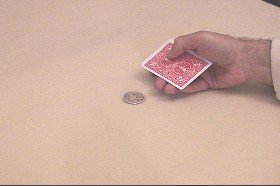| surface of the table such as the coin. If the fingers picked up the coin in the process |
| just outlined, the coin would be showing as the hand turned. To perform an |
| appropriate deception this motion changes. |
| The difference between the most natural way and the method used in Matrix is very |
| small. Yet this method allows the coin to be picked up while it is apparently covered. |
| In this method we begin in the same way, three cards are held in dealing position in the |
right hand.  Again, the thumb pushes the top card to the left. Again, the thumb pushes the top card to the left.  However, as However, as |
| the top card is slid toward the table, the hand does not rotate or rotates only a small |
| amount. The card moves as far to the left as the thumb can push it. The cardís |
edge hits the table.  |
| Now, instead of turning the hand palm down to move the card to the table, the card left |
| edge rests on the surface of the table while the thumb releases the card and moves to |
the right where it holds the other cards in the hand.  Then the hand moves briskly Then the hand moves briskly |
| to the right. The motion of the hand to the right allows the first card to fall directly on |
to the coin.  |
| Note that both of these methods accomplish the same thing. A card covers a coin. The |
|
|  |
